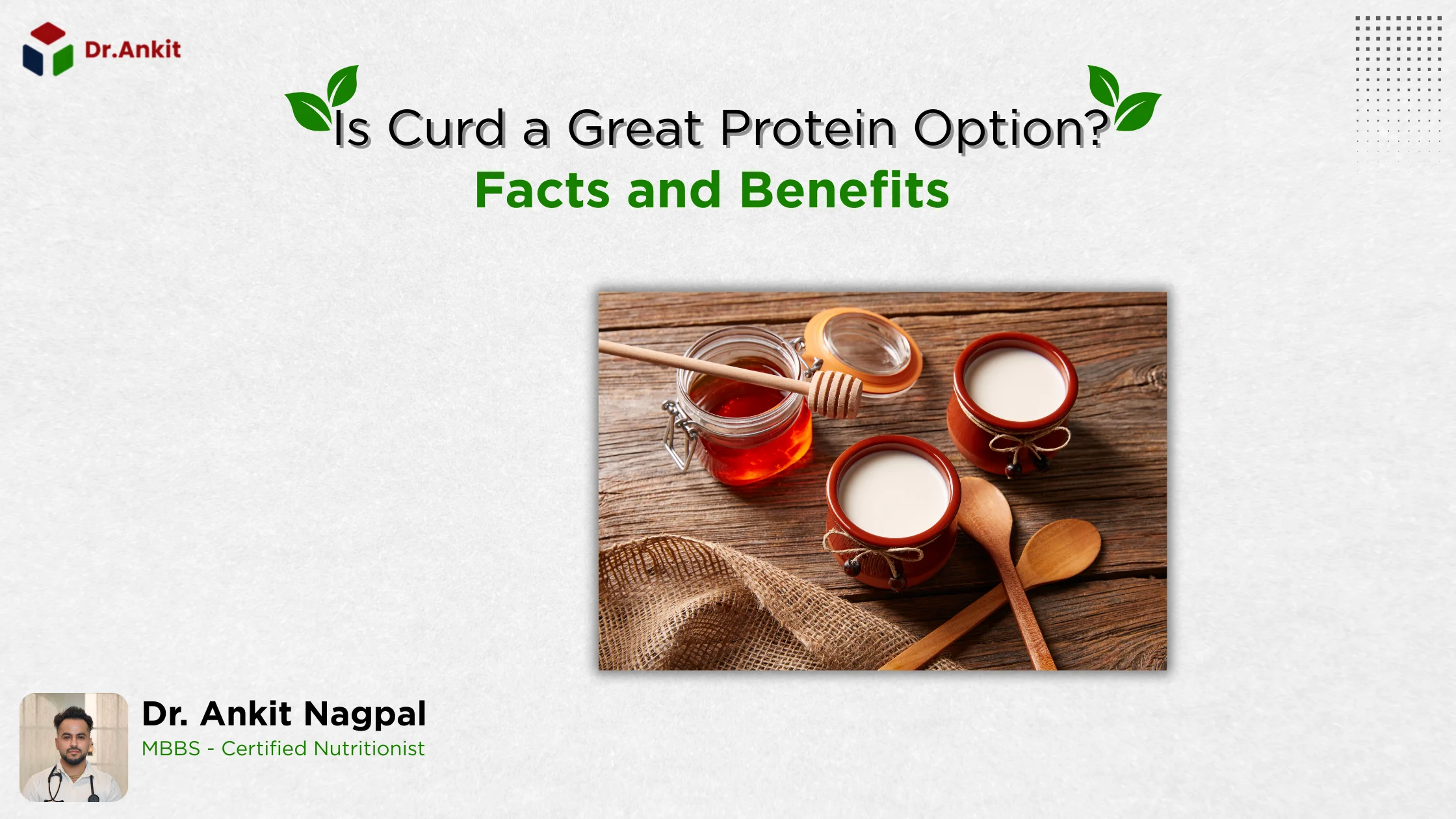Summary
In this deep dive, we’ll explore why curd shines as a protein powerhouse for vegetarians in India, delivering about 3.5-5 grams per 100 grams depending on the type. But it’s not alone—we’ll tour veg protein sources India, spotlight the best Indian vegetarian source of protein, and chart out vegan protein sources chart options for those skipping dairy altogether. Expect practical tips, health perks like better digestion and muscle support, and budget hacks using cheap staples like lentils and sattu.
By the end, you’ll have a roadmap to hit your protein goals without fancy supplements. Whether you’re a busy parent or a fitness newbie, these insights from my clinic chats will make your dal-rice routine a nutrient ninja. Let’s get into it—your body will thank you!
Introduction
Hey there, friends! I am Dr Ankit Nagpal as a doctor who’s spent years helping folks in India balance their plates with smart, everyday foods,I love diving into chats like this. Protein isn’t just gym-bro talk—it’s the building block that keeps your muscles humming, your energy steady, and your immune system on guard. And for us vegetarians (that’s most of us here!), finding reliable sources without breaking the bank is key. In my recent blog post I talked about blog post for PCOD diet chart for females in which i emphasised about benefits of curd. And now in this blog I as the best dietitian in Ludhiana will share in detail why consuming curd is great protein option.
Today, we’re zeroing in on curd—that creamy, tangy staple in every Indian kitchen—and asking the big question: Is curd a good source of protein? Spoiler: It packs more punch than you might think, especially when teamed up with other desi gems. Stick around as we unpack the facts, benefits, and a whole lot more to supercharge your meals.
Picture this: It’s a sweltering Delhi afternoon, and you’re craving something cool, gut-friendly, and guilt-free. Enter curd—dahi to us desis—a fermented milk wonder that’s been cooling tempers and fueling families for centuries. But beyond its role in raita or lassi, is it pulling its weight in the protein department? As someone who’s counseled hundreds of patients on vegetarian diets, I can tell you straight: In a country where most of us skip meat, nailing protein intake is non-negotiable. We’re talking everything from repairing tissues after a long day to keeping those bones strong as you age.
Now, let’s be real—protein myths run wild. Some swear by expensive whey shakes, while others think paneer is the only hero. Truth? Curd fits right in as an accessible, probiotic-packed option that supports muscle health and even weight management. And is curd a good source of protein? Absolutely, especially when you factor in its complete amino acid profile from milk origins. But to make it a “great” option, we pair it with India’s bounty of plant-based powerhouses.
In the sections ahead, we’ll break it down: From curd’s nitty-gritty nutrition to broader sources of protein in India, including affordable picks and vegan twists. I’ll keep it chatty, like we’re grabbing chai together, because nutrition shouldn’t feel like a lecture. By weaving in traditional eats like sattu and modern hacks, you’ll see how easy it is to build a protein-rich plate. Ready to rethink your thali? Let’s roll.
Is Curd a Good Source of Protein?
You bet it is, folks! As a certified nutritionist, I’ve seen curd transform “meh” diets into muscle-maintaining machines. But let’s cut through the fluff—is curd a good source of protein? Yes, and here’s why it deserves a spot on your daily menu. Clocking in at 3.5 grams per 100 grams for plain full-fat versions, it edges up to 5 grams in low-fat ones, and Greek-style hung curd hits 10 grams. That’s not eggs-level, but for a cool, versatile food, it’s a winner—especially with its bonus probiotics that amp up absorption.
Protein Content in Curd: Breaking Down the Numbers
Ever wondered why your grandma’s homemade dahi feels like a hug in a bowl? It’s that steady protein drip. Per 100 grams, expect about 3.5 grams from standard curd, making a 200-gram bowl deliver 7 grams—enough to kickstart your day or recover post-yoga. Low-fat? Bump it to 4-5 grams, ideal if you’re watching calories. And for the gym crowd, straining it into Greek yogurt doubles that to 10 grams, rivaling some protein bars without the additives.
But here’s the kicker: Curd’s protein is “complete,” meaning it has all nine essential amino acids your body can’t make. Pair it with rice or roti, and you’ve got a balanced meal that rivals meat. In my practice, patients swapping snacks for curd report steadier energy—no more 3 PM crashes. Just remember, homemade trumps store-bought for live cultures and freshness.
Health Benefits of Curd’s Protein for Everyday Wellness
Protein from curd isn’t just filler—it’s a multitasker. It aids muscle repair, crucial if you’re chasing those stairs in Mumbai traffic or lifting kids around. Curd’s proteins digest slower than milk’s, giving sustained release for all-day satiety. Plus, with calcium tag-teaming at 132 mg per 100 grams, it’s a bone-boosting duo against osteoporosis.
Gut health? Curd’s probiotics team up with protein to fight inflammation and ease IBS—I’ve had clients ditch antacids after adding it daily. And for weight watchers, that fullness factor curbs munchies, supporting steady loss without hunger pangs. Diabetics love it too; low GI keeps blood sugar chill. Bottom line: Is curd a good source of protein? For holistic health, heck yeah—it’s like your friendly neighborhood superfood.
Ways to Maximize Curd’s Protein Punch in Indian Meals
Tired of plain bowls? Spice it up! Blend with sattu for a 15-gram protein lassi, or top salads with hung curd dressing. In curries like kadhi, it sneaks in 10 grams per serving. Pro tip: Ferment overnight for extra tang and nutrients. Your thali just leveled up.
Veg Protein Sources India
India’s veggie scene is a protein paradise if you know where to look. From bustling markets to home kitchens, veg protein sources India are affordable and flavorful—think dals simmering on the stove. As a doc who’s prescribed these for protein-deficient patients, I can vouch: They’re not just fillers; they’re fuel for vibrant living.
Top Legumes and Pulses as Everyday Heroes
Legumes rule the roost here—lentils (dal) pack 18 grams per cooked cup, chickpeas (chana) 14.5 grams. Rajma? 19 grams per 100 grams dry. These aren’t fancy, but they’re cheap (under ₹100/kg) and versatile in curries or salads. Their fiber bonus keeps cholesterol in check, a big win for heart health in our carb-heavy diets. Sprout them for a protein boost—I’ve seen energy soar in clinic trials.
Black-eyed peas (lobia) and moong dal add variety, hitting 20+ grams dry. Pair with rice for complete proteins, mimicking meat’s profile. In Bihar or UP homes, these are staples—proving you don’t need imports for gains.
Dairy Delights and Plant Twists for Balanced Plates
Don’t sleep on dairy: Paneer delivers 18 grams per 100 grams, curd we know, and milk 3.5 grams per glass. For variety, tofu (soy paneer) clocks 8 grams—steam it into bhurji. Nuts like peanuts (25 grams/100g) sprinkle in for crunch. These veg protein sources India shine in mixed meals, ensuring no amino acid gaps. My advice? Rotate weekly for micronutrient magic.
Best Indian Vegetarian Source of Protein
When I grill patients on their plates, one name pops up: Sattu. Hands down, it’s the best Indian vegetarian source of protein for its bang-for-buck ratio. Roasted gram flour, it’s a Bihar favorite that’s sweeping the nation—and for good reason.
Spotlight on Sattu: Is Sattu a Good Source of Protein?
Is sattu a good source of protein? Oh, absolutely—20-25 grams per 100 grams, outpacing many rivals. That’s like a mini steak for veggies! One tablespoon (20g) nets 4-5 grams, perfect for sherbets or parathas. Beyond protein, it’s fiber-rich for digestion and cooling for summer heat. In my nutrition workshops, folks report better satiety and steady blood sugar—ideal for diabetics.
It’s complete-ish when mixed with milk, and loaded with iron for anemia-prone Indians. Downside? Taste takes tweaking, but lemon-sattu drinks? Game-changer.
Other Stars: Paneer, Lentils, and Beyond
Paneer ties at 18 grams/100g—grill it for tikkas. Lentils follow at 9 grams cooked cup, kidney beans 8 grams. These best Indian vegetarian source of protein are local, seasonal, and soul-satisfying. Mix ’em up to dodge boredom and maximize benefits.
Best Protein Sources for Vegetarians in India
For my vegetarian crew juggling jobs and workouts, the best protein sources for vegetarians in India are those that fit your life—tasty, quick, and wallet-friendly. From soy chunks to quinoa (if you splurge), they’re everywhere.
Affordable and Accessible Choices for Daily Wins
Start with chickpeas—14.5 grams/cup, dirt-cheap at markets. Soy chunks (nutrela) hit 52 grams dry—boil into curries for 25 grams/serving. Peanuts and sprouts round it out under ₹50/day. These keep you full, fighting that mid-day slump I hear about nonstop.
Complete Proteins for Balanced, Bulletproof Nutrition
Quinoa (12g/cup) and amaranth offer full aminos, but stick to buckwheat for desi vibes. Combine with curd for synergy—is curd a good source of protein? When paired, yes, elevating your intake effortlessly. Track with apps; aim 1g/kg body weight.
Cheap Protein Sources India
Budget blues? No sweat—cheap protein sources India are your secret weapon. At ₹20-50/kg, they’re clinic staples for underfed urbanites.
Budget-Friendly Legumes That Punch Above Their Weight
Moong dal: 24g/100g dry, cooks in 20 minutes. Chana: Versatile for chaat. These fill half your needs for pennies, plus B vitamins for energy.
Homemade High-Protein Staples Like Sattu Mixes
Roast your own sattu—pure profit at 20g/100g. Whey from paneer-making adds bonus. Is sattu a good source of protein? Twice over for thrifty eats. Batch-prep for weeks.
Sources of Protein in India
Our sources of protein in India blend tradition and innovation—dal to protein-enriched rotis.
Traditional Indian Foods That Built Generations
Dal makhani (15g/serving), idli with sambar (10g). These fed our ancestors strong.
Modern Twists for the Urban Hustle
Fortified atta or overnight oats with nuts—20g easy. Is curd a good source of protein? In smoothies, it modernizes classics.
Vegetarian Protein Sources India
Vegetarian protein sources India thrive on diversity—nuts to greens.
Nuts and Seeds: The Crunchy Powerhouses
Almonds (21g/100g), chia (17g). Handfuls add 5-10g.
Grains and Pseudo-Grains for Sustained Energy
Oats (13g/cup), barley. Millet mixes hit 12g.
Vegan Protein Sources Chart
For dairy-free dynamos, here’s a vegan protein sources chart tailored to Indian kitchens:
| Food Item | Protein per 100g (approx.) | Cost (₹/kg) | Best Use |
| Lentils (dry) | 25g | 80-100 | Dal, soups |
| Chickpeas (dry) | 19g | 60-80 | Chana masala |
| Sattu | 22g | 100-120 | Drinks, rotis |
| Tofu | 8g | 150-200 | Stir-fries |
| Peanuts | 26g | 100-150 | Snacks, chutney |
| Quinoa | 14g (cooked) | 400+ | Salads |
| Soy Chunks | 52g (dry) | 100-150 | Curries |
Key Vegan Proteins for Muscle and More
Legumes lead—edamame 11g/100g. Hemp seeds? 32g, if available.
Sample Daily Intake for a 60kg Adult
Breakfast: Sattu lassi (15g). Lunch: Rajma rice (20g). Snack: Nuts (10g). Dinner: Tofu stir-fry (15g). Total: 60g—easy peasy.
FAQs
A: Yep! Its protein promotes fullness, and low cals (60/100g) make it ideal. Add veggies for a salad boost.
A: 200-300g gives 7-15g—pair with nuts for 20g total.
A: Coconut or almond yogurt, 2-5g/100g, but less probiotic punch.
A: Sattu edges higher (22g vs 3.5g), but curd wins on digestibility. Mix ’em!
A: Lentils—versatile and under ₹100/kg.
A: Absolutely, but vary for growth—curd parfaits are fun
There you have it, friends—curd’s your gateway to protein prowess. Drop a comment if you’ve tried these; let’s chat nutrition. Stay healthy!


